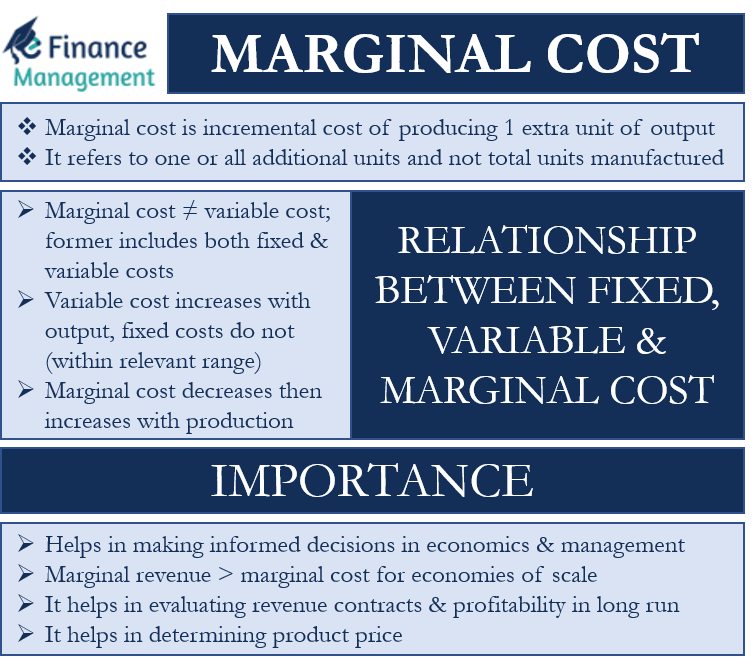You would agree that when a manufacturing unit increases the level of production, the total cost of production will also increase. This increment in the ‘total cost’ for producing ‘one additional unit’ of output is called the marginal cost. In other words, it is the additional/incremental cost incurred for producing one extra unit of output. Please note that the marginal cost is always used in the context of production of that one or all the additional units and not the total units that are being manufactured. Let’s clarify this with the help of an example below.
Explanation with Example
Assume that it cost $200 to company X for manufacturing 10 toys. When it produces 11 units of toys, the total cost increases to $210. This increase of $10 (210-200) is the marginal cost for producing the 11th unit of the toy.
Or, say that the company incurs the additional cost of $50 to produce 5 extra units. In this case, the marginal cost of each of the 5 units is $10.
The concept of marginal cost is most utilized for decision-making. The two very crucial areas that use the concept are:
- economics and
- managerial decision-making.
The concept of the marginal cost comes with a bundle of questions and these include:
- How do we calculate the marginal cost?
- Is marginal cost and variable cost the same?
- Does the marginal cost include fixed cost? etc.
This article will answer all these queries. Let us start with the formula.
How to Calculate Marginal Cost?
| Marginal Cost = Change in Total Cost / Change in the Level of the Output |
Or,
| Marginal Cost = Additional Cost incurred for producing Extra Output / Number of Additional Units of Output |
Total cost here refers to the total cost of production which includes both fixed and variable costs. You might have a question that “does marginal cost only include variable cost or does it also include fixed cost?”. The answer to this question is quite tricky. It includes both fixed and variable costs but the concept exists only because of variable costs. Before diving deep into its explanation, you must have clarity about the fixed cost and the variable cost and their relationship with the marginal cost.
Also Read: Marginal Revenue

Relationship between Fixed, Variable and Marginal Cost
Fixed costs are the cost that remains the same at each level of production in the short run. These costs do not have any direct relationship with the number of units produced. On the contrary, the variable costs have a direct relationship with the number of units manufactured. Total variable costs are the costs that keep increasing with the increase in the level of production while the per-unit variable cost remains the same for every single unit.
You might have come across various studies where marginal costs are kept at par with variable costs. But it is not true. Both the costs are different from each other because the variable cost is a part of marginal cost and it includes both fixed and variable costs. The reason why both are considered the same is that people think that the only cost that increases with the level of output is a variable cost and which is true to a great extent. But what if the company needs to buy or lease machinery for manufacturing the additional units? Or, how will the rent expense (being a fixed cost) affects the marginal cost if the company needs extra space or a warehouse facility to store raw material for those extra units? The fixed cost, in these cases, will also increase due to the increment in the output.
The fixed costs are ignored because this increment is not attached to an individual unit. This incremental cost is associated with all the units that can be produced by incurring this additional fixed cost. It is going to remain the same whether you produce one unit or n number of units in its relevant range. And, eventually, this affects the marginal cost as the total cost of production increases.
So, when the production is low, the marginal cost is higher and when the production increases, the marginal cost decreases until it reaches its bottom line and starts increasing again. A marginal cost curve will demonstrate this in an easy manner.
Importance of Marginal Cost
As already stated, the two important disciplines that use this concept are economics and managerial decision-making. The best quality of this cost concept is that it helps management make various informed decisions. Since, at any point in time, for management, it is important to ensure that their marginal revenues should be more than marginal costs and at what point they will be able to achieve economies of scale. Knowledge of marginal costs helps them evaluate the revenue contracts. And whether this will increase the company’s profitability in the long run or not.
Also, it helps in deciding the price of the product. What if the company prices its product below marginal cost? Pricing a product below marginal cost means inviting losses because neither the price is covering the variable costs nor will it contribute anything towards fixed costs. Still, some companies may choose to price their products below the marginal cost under certain special situations. The strategy of the company normally guides these situations. The company may be in the nascent stage of its product and may wish to capture the market share. At times, it may also be for running the machinery to maintain its good condition in bad product-market situations.
Refer to Marginal Costing Ratios Calculator.

